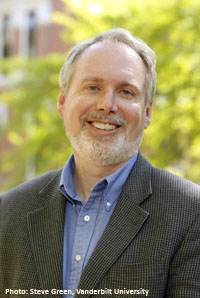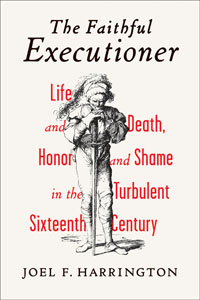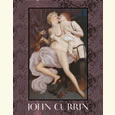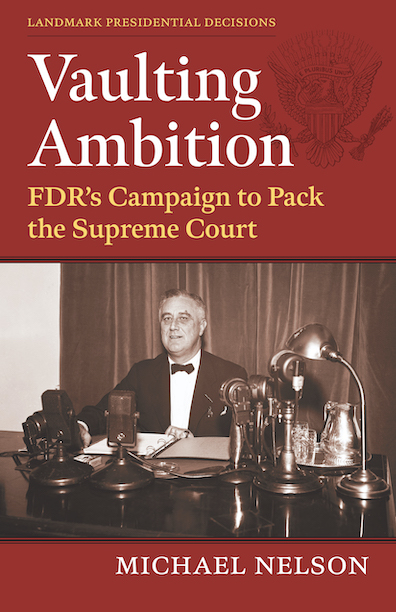Death Becomes Him
In The Faithful Executioner, Joel Harrington examines the meaning of justice, honor, and the law in Reformation-era Europe
During the late sixteenth century, the city of Nuremberg was a bustling commercial metropolis at the heart of the Holy Roman Empire. As one of the first cities to convert to Lutheranism in the 1520s, it was also on the front lines of the Reformation. In The Faithful Executioner: Life and Death, Honor and Shame in the Turbulent Sixteenth Century, Vanderbilt historian Joel Harrington considers this world as it is revealed in the extensive diary of Frantz Schmidt, the city’s public executioner for more than forty years.
 What thoughts go through the mind of someone carrying out the execution of another human being as part of a public spectacle? Schmidt experienced this moment dozens of times, but his thoughts and feelings about what he was doing would have been largely inscrutable both to his employers and to the masses in the crowd watching him do his job. Fortunately for historians, Schmidt chronicled each of his executions in an extensive and often highly detailed personal record of his career. Having stumbled across Schmidt’s diary while in a Nuremberg bookstore, Harrington has used it to give a compelling account of the executioner’s life and career. In the process, readers also gain a rich understanding of what law and order, justice, and public rituals of punishment meant to sixteenth-century German society.
What thoughts go through the mind of someone carrying out the execution of another human being as part of a public spectacle? Schmidt experienced this moment dozens of times, but his thoughts and feelings about what he was doing would have been largely inscrutable both to his employers and to the masses in the crowd watching him do his job. Fortunately for historians, Schmidt chronicled each of his executions in an extensive and often highly detailed personal record of his career. Having stumbled across Schmidt’s diary while in a Nuremberg bookstore, Harrington has used it to give a compelling account of the executioner’s life and career. In the process, readers also gain a rich understanding of what law and order, justice, and public rituals of punishment meant to sixteenth-century German society.
Schmidt occupied a critical place in the city’s public life, both professionally, where he was charged with protecting upright citizens from the criminal element, and personally, with his own social status in a hazy “no-man’s land” between respectability and disrepute in the eyes of Nuremberg’s residents. Harrington uses Schmidt’s diary to unpack the meanings behind the practical and symbolic implementation of justice in the city and to describe Schmidt’s personal quest to attain “respectability” and ensure a better life for his offspring. The result is an excellent example of micro-history—the use of a single person’s life to examine broader social and cultural trends—and a book that pushes us to re-examine our pre-conceptions about the “barbaric” nature of justice in the early-modern world.
Harrington answered questions from Chapter 16 via email.
Chapter 16: “Public executioner” is a term that conjures up a fairly brutal and barbaric image, though that’s not how Schmidt himself comes across in your book. Is he an exception, or is our image of sixteenth-century justice wrong?
Harrington: Meister Frantz’s lifetime (1554-1634) actually corresponded to a time of dramatic transition in European criminal-law enforcement. Early in his career, legal authorities got rid of most of the most extreme punishments—such as live burial and public castration—and Schmidt himself helped abolish the drowning of women in Nuremberg. They retained some public punishments, however, that seem almost cruel to us, including death by the wheel, mainly to help bolster their own reputation.
By the end of Schmidt’s career, though, these same authorities felt secure enough to reduce such punishments to simple beheadings or outright pardon. Workhouse sentences also became more common for career thieves. This entire legal revolution hinged on a simultaneous shift to more professional and dispassionate executioners such as Frantz Schmidt—a dramatic contrast to the days of Frantz’s father (also an executioner), when most practitioners were shady characters, barely distinguishable from their criminal victims. So you could say that Meister Frantz was a pioneer in this respect.
 Chapter 16: You point out the absolute necessity for a city like Nuremberg to have a public executioner, and you make it clear that the citizens appreciated having one as honest and competent as Schmidt. And yet alongside this gratitude was their insistence that he be excluded from “respectable” society. How did people reconcile these apparently contradictory impulses?
Chapter 16: You point out the absolute necessity for a city like Nuremberg to have a public executioner, and you make it clear that the citizens appreciated having one as honest and competent as Schmidt. And yet alongside this gratitude was their insistence that he be excluded from “respectable” society. How did people reconcile these apparently contradictory impulses?
Harrington: It was a huge contradiction and one that obviously caused Schmidt a lot of consternation. Even more amazing, there were countless superstitions about bad luck emanating from “the executioner’s touch,” yet thousands of patients came to Meister Frantz’s residence to be healed by him over the course of the long career. Yet when you think about other societies with segregation or ostracism, there are often the same hypocritical examples of members of “proper society” at various times interacting with and even relying on individuals otherwise deemed disreputable. (We certainly don’t have to go back very far in U.S. history for examples close to home.)
In the Schmidt family’s case, there was a gradual lessening of popular suspicion and even some signs of respect later in Frantz’s life, such as his neighbors serving as pallbearers at his wife’s funeral. Overall, though, the social isolation remained intense. Fittingly, the Hangman’s House was itself on an island, with a respectable neighborhood on one shore and a prison on the other.
Chapter 16: In addition to charting his career as an executioner, you also describe Schmidt’s life-long attempt to have his family’s honor restored so that his children would not have to follow in his footsteps. Why was it so important during Schmidt’s time to be designated “honorable”?
Harrington: Early-modern European societies were obsessed with individual and collective honor. Every public occasion and virtually every private interaction was a vulnerable time, with one’s honor at risk. Insults such as “traitor” and “witch” usually led to blows, often fatal. In a rigidly hierarchical society, a person was always trying to protect his or her own honor so as not to be pushed down the ladder.
In practice, this meant lots of rules and rituals to be observed in everything from public processions to drinks at a tavern. It also meant that those most vulnerable—such as lower-class artisans—were the most eager to punish those they considered beneath them, particularly executioners. There were also more formal implications of being deemed dishonorable. Meister Frantz wanted respect, but he also wanted a variety of legal rights that were denied him and his children because of their officially dishonorable status. The biggest question in my mind is not Why did he seek a formal restitution of honor? but Why did he wait six years after retiring to seek the social remedy he had dreamt about his entire life?
Chapter 16: The Nuremberg city fathers saw public executions as a way to emphasize their ability to maintain law and order, but for spectators they often seemed to be a form of macabre entertainment. Was there any concern that people were enjoying the spectacles too much, perhaps undermining their purpose as a deterrent?
Harrington: Surprisingly, this issue was not really much discussed—at least not in writing—until the eighteenth century, by which time the number of public executions had declined considerably since the time of Meister Frantz. Maintaining some semblance of public order, however, was always important. Whether or not government officials really believed in the supposed deterrence of such spectacles, they very much wanted a well-orchestrated illustration of their own power, as well as a chance at religious redemption for the condemned person. In the book, I discuss how much of this responsibility fell on the executioner, and how every public execution had the potential to turn into a counterproductive riot if things didn’t go as planned.
Chapter 16: Even though the Reformation and the consequent religious wars were playing out throughout the time covered by your book, they do not seem to feature very much in Schmidt’s diary or in the administration of justice in the city as a whole. Were Schmidt and Nuremberg unusual in this regard? Or was there already a trend toward a more secular outlook among urban patrician elites?
Harrington: To the contrary, the city of Nuremberg was a leader in the evangelical (Lutheran) cause, and Frantz Schmidt was himself widely reputed to be a pious believer (supported by comments in his journal). The public execution itself was a religious ritual, comprised of contrition (a gallows speech), penance (death), and the possibility of salvation.
One primary source that I used quite a bit was a journal kept by one of the prison chaplains at the same time as Schmidt’s journal. Both men clearly believed in the redemptive possibility of their work, though the chaplain was much more concerned about the condemned learning articles of faith, while the executioner valued public contrition, traditionally completed by administration of the Eucharist before death.
I also think that Frantz’s apparently sincere faith provided him with a great deal of comfort during various personal losses and a lifetime of administering violence in the name of justice. One of the most touching examples of this piety is a Meisterlied he composed that combines evangelical and medical themes—both very dear to him.
Chapter 16: As you note, one of the difficulties of recreating Schmidt’s thoughts and feelings is that he used little emotional or introspective language in his diary entries. How did you approach this challenge in developing a coherent intellectual profile for Schmidt?
Harrington: At first I didn’t think it would be possible to capture any of his interior life. The journal is actually less of a diary than a professional chronicle. Once I found his petition for restoration of honor, though, I knew both the backstory to his family’s falling into the profession and the primary motivation that kept him going for so many years. After that, the patterns I had detected in his emotional responses to certain individuals and crimes all started to fall into place, and a more coherent picture emerged. A very close reading of the text, countless times, also revealed an unexpected passion in his choice of words and descriptions. Another breakthrough was when I became more conscious of how his writing (and some of his ideas) evolved over the course of forty-five years. As would be the case for most of us.
[This interview appeared originally on April 24, 2013.]
Joel Harrington will appear at the twenty-fifth annual Southern Festival of Books, held in Nashville October 11-13. All festival events are free and open to the public.





